Are you struggling to turn customer inquiries into sales opportunities? Do you feel that slow response times are causing potential leads to lose interest?
Sales can slip through the cracks without an efficient way to manage customer interactions. That’s where customer support and a robust help desk ticketing system are crucial to enhance the sales cycle.
Let’s explore how streamlining customer support with the right tools improves service, drives conversions, nurtures leads, and boosts overall customer satisfaction.
What is the sales cycle?
A sales cycle refers to the series of steps that a sales team follows to convert a potential lead into a customer. It’s a structured process that begins with prospecting and identifying leads and ends with closing the deal or extending to post-sale activities like follow-up emails.
The sales cycle typically varies in length and complexity depending on the industry, type of product or service, and the buyer’s decision-making process.
Good sales cycle management refers to overseeing, optimizing, and streamlining the sales cycle steps. It ensures that leads are moved through each stage and converted into paying customers.
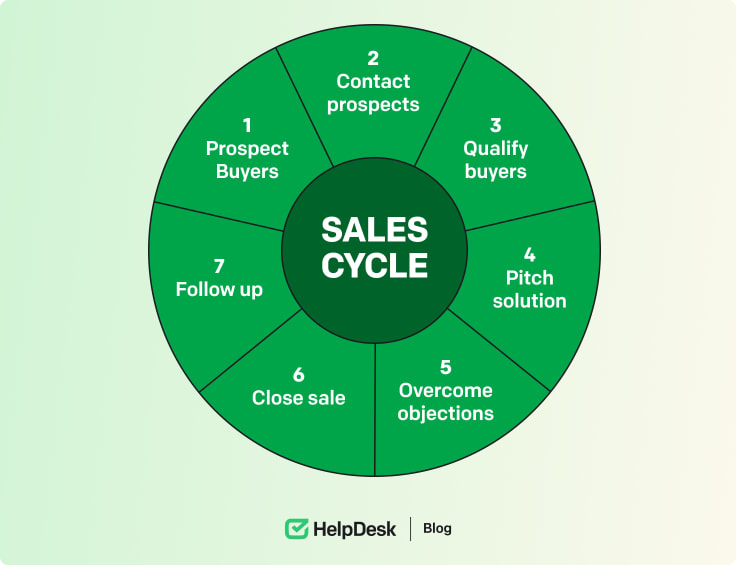
Understanding the sales cycle and customer support’s role
More businesses recognize that adequate customer support is not just a post-sale activity but a strategic asset. It can influence every sales cycle phase and stage, from prospecting to customer retention.
1. Prospecting and first impressions
The sales cycle begins with prospecting, where sales teams seek out potential customers. In this stage, first impressions are critical. When prospects have questions or concerns, the speed and quality of customer service they receive can heavily influence their perception of the business.
How customer support enhances this stage:
-
Quick response time: Fast responses are essential when prospects ask questions. The help desk ticketing system ensures inquiries are immediately logged, categorized, and assigned to suitable support agents.
-
Accurate information delivery: First impressions can be made or broken based on the information provided. Well-trained support agents with a knowledge base ensure prospects get clear, precise answers, reducing the friction in their decision-making process.
Example: If a prospect contacts a company through live chat to inquire about a product’s features, the quick response could be the turning point in the prospect’s decision to proceed with the company.
2. Lead nurturing
Once a prospect is engaged, the next sales cycle phase is lead generation and nurturing. This phase involves building relationships with potential buyers by addressing their needs and concerns. Customer support is crucial in maintaining consistent and personalized communication.
How customer support enhances this stage:
-
Personalized support: The help desk ticketing system can store customer data and history, allowing support agents to provide tailored advice and solutions based on previous interactions.
-
Proactive problem solving: Customer support teams can identify common challenges leads face and proactively offer solutions. For instance, if a lead frequently asks about product compatibility, support can provide in-depth resources or schedule a demo to address concerns.
Example: A software company using a ticketing system might notice a lead submitting multiple questions about integration capabilities. Rather than waiting for the lead to follow up, a support agent could proactively reach out with a comprehensive guide or offer a one-on-one consultation, showing the company’s commitment to solving the lead’s issues.
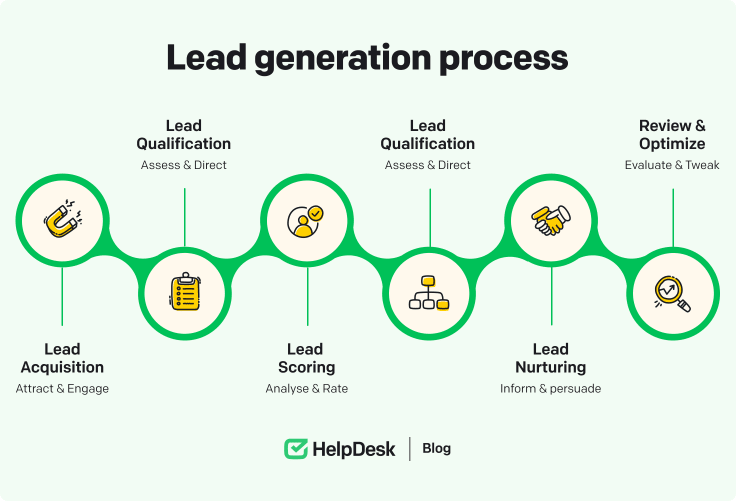
3. Closing the deal
At this stage, the focus shifts to sealing the deal and converting a lead into a paying customer. Many businesses need to realize that customer support can be the deciding factor in this phase, especially when the lead has last-minute concerns or technical queries that need addressing before making a final purchasing decision.
How customer support enhances this stage:
-
Overcoming last-minute objections: Prospective customers often hesitate right before making a purchase. Armed with knowledge from previous tickets, customer support teams can provide reassurance, whether clarifying a product feature, explaining pricing plans, or offering a customized solution.
-
Handover from sales to support: Help desk ticketing systems help create a smooth transition from the sales team to the customer support team. It ensures that any unresolved queries or negotiations are swiftly addressed, preventing potential delays in closing the sale.
Example: Imagine a lead on the verge of purchasing an enterprise software solution with one final concern about data security. With the help of a ticketing system, the support agent can quickly access the lead’s history and respond with detailed security specifications, giving the prospect confidence to proceed with the purchase.
4. Post-sale support and customer retention
Customer support becomes most visible in the post-sale stage, where the focus shifts to ensuring customer satisfaction, addressing any issues, and laying the groundwork for repeat business.
How customer support enhances this stage:
-
Issue resolution: The help desk system allows support teams to resolve post-sale issues swiftly. Tickets are tracked when customers raise concerns, ensuring everything is noticed promptly.
-
Opportunities for upselling and cross-selling: Customer support teams can identify upselling or cross-selling opportunities with access to customer history. For example, a support agent might notice that a customer has submitted multiple tickets about a feature not available in their current plan and suggest upgrading to a more advanced version.
-
Building long-term relationships: The relationship doesn’t end with the sale. Customer support ensures that customers feel valued even after the purchase, whether through follow-up calls, satisfaction surveys, or offering additional training resources.
Example: A company offering cloud services might use its ticketing system to track customers’ ongoing requests for additional storage. Over time, support could suggest a higher-tier plan that provides the extra space the customer needs, improving the customer’s experience while generating additional revenue for the business.
Learn more about retention. Read our Learning Space guide about Customer Retention Strategies. 🚀
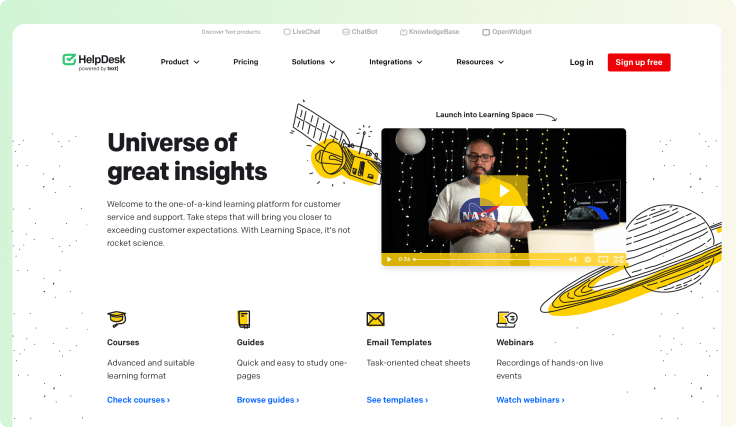
5. Continuous feedback loop
Customer support enhances the sales cycle and provides invaluable insights that can help refine sales strategies. With the help desk system, support teams can track frequently asked questions, common pain points, and reasons for hesitation and relay this information to the sales team.
How customer support enhances this stage:
-
Data-driven decision-making: Businesses can identify trends and make data-driven sales and support process adjustments by analyzing ticket data. For example, suppose several leads drop out due to concerns over complex onboarding. In that case, the sales team can use that insight to adjust their pitch or create educational resources to ease concerns earlier in the cycle.
-
Improved customer retention strategies: Post-sale support data helps businesses identify at-risk customers early, allowing sales and support teams to implement proactive retention strategies, such as offering incentives or personalized outreach.
Example: A SaaS company might notice through ticketing system analytics that most churned customers had issues with the user interface. By feeding this data back to the sales and product teams, they can adjust the sales pitch to better set customer expectations or improve the onboarding experience.
Customer support is no longer just a post-sale service but a vital component that enhances every sales cycle stage. HelpDesk’s ticketing system amplifies this role by providing structure, organization, and data, ensuring customer inquiries are handled quickly. Align sales and support efforts, and businesses can optimize every customer interaction to create lasting relationships and unlock more growth opportunities.
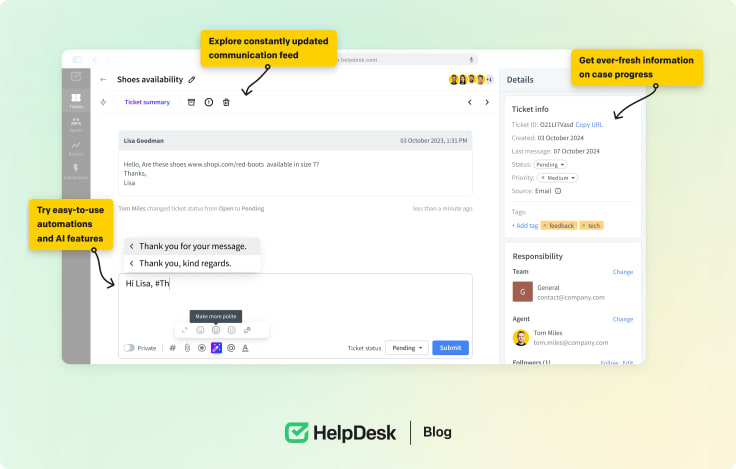
Techniques to shorten your sales cycle
The longer it takes to close a deal, the more likely leads will lose interest or be swayed by competitors. Shortening the sales cycle allows businesses to close more deals in less time.
Qualify leads early
Ensure you’re working with qualified leads from the outset. Many sales teams waste time nurturing prospects who are not the right fit for the product. To help your sales rep avoid this, qualifying criteria like BANT (Budget, Authority, Need, Timing) or CHAMP (Challenges, Authority, Money, Prioritization) should be used to assess the quality of leads.
-
Implement lead scoring: Lead scoring systems automatically rank leads based on their buying likelihood, helping sales teams focus on high-priority prospects.
-
Use pre-qualification surveys: These surveys can be sent via email or on your website to gather information about prospects before they enter your sales pipeline, filtering out less viable leads early on.
Automate repetitive tasks
Sales teams often spend too much time on administrative tasks, such as following up with leads or scheduling meetings. By automating these tasks, sales leaders can free up time to focus on more critical aspects of the sales process, like building relationships and closing deals.
-
Email automation: Automated follow-up emails ensure prospects receive timely responses without sales reps needing to intervene manually.
-
CRM systems: Customer relationship management (CRM) tools can automate data entry, task assignments, and even some aspects of communication, ensuring that no lead falls through the cracks.
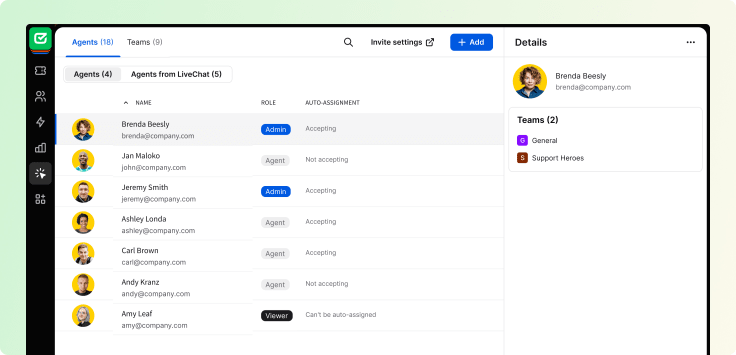
Leverage content to address objections early
Prospects often have similar questions and objections that can prolong the decision-making process. By creating targeted content that addresses common concerns, you can reduce back-and-forth conversations and provide leads with the information they need to move forward quickly.
-
Create an FAQ section or knowledge base on your website. By compiling answers to frequently asked questions, prospects can find the information they need without waiting for a sales rep’s response.
-
Offer case studies and testimonials. Sharing customer success stories early in the cycle can help overcome objections to trust, value, and product effectiveness.
Simplify your sales process
A complicated sales process with too many steps can overwhelm prospects and delay decision-making. Streamlining your process by removing unnecessary steps or bottlenecks can shorten the time to close deals.
Prospects often delay decisions when pricing is unclear. Providing transparent pricing from the start can eliminate confusion and expedite the purchasing decision.
Moreover, incorporating digital contracts and e-signature tools allows prospects to sign agreements quickly without dealing with the delays of physical paperwork.
You can also develop a sales playbook that outlines best practices, messaging, and common objections with prepared responses.
Follow up strategically
Timely follow-ups are essential for moving prospects through the sales funnel. However, overly aggressive or poorly timed follow-ups can have the opposite effect. Strategize your follow-ups based on prospect behavior, using CRM data to determine the optimal timing.
-
Track engagement: Use tracking tools to see how leads interact with your emails, proposals, or website. Follow up when they are most engaged.
-
Send personalized reminders: Rather than generic follow-up emails, tailor your communication to address the prospect’s specific needs or concerns, showing that you understand their pain points.
How does the HelpDesk ticketing system optimize each stage of the sales cycle?
The HelpDesk ticketing system, specifically designed for customer support teams, plays a pivotal role in optimizing the well-defined sales cycle through:
Improving response times
One of the most critical factors in the typical sales cycle is speed. Customers and prospects expect fast, accurate responses to their inquiries. Delays in resolving issues or answering questions can lead to lost leads or dissatisfied customers.
The HelpDesk ticketing system reduces response times by organizing and prioritizing incoming queries to address the correct issues promptly.
-
Organized ticket resolution: It automatically assigns and prioritizes tickets based on urgency. It prevents leads from being neglected and quickly resolves high-priority issues. As a result, prospects stay engaged, feeling that their concerns are taken seriously.
-
Quick turnaround: The faster a potential customer gets answers, the more likely they will move forward in the sales cycle. By resolving issues efficiently, sales processes are accelerated.
Facilitating collaboration between support and sales
The sales and customer support teams must collaborate for the sales cycle to flow efficiently. The HelpDesk ticketing system enhances this collaboration by providing real-time ticket updates that inform the sales team about customer pain points and preferences.
The ticketing systems sync with CRM platforms, providing sales teams valuable insights into customer behavior and preferences. It ensures that salespeople are fully aware of any issues the customer has faced, enabling them to tailor their pitches accordingly.
Streamlining workflows with automation
Automation is one of the most significant advantages of a HelpDesk ticketing system. Automation tools streamline complex workflows, ensuring that repetitive tasks are handled efficiently.
It allows customer support teams to provide quick and accurate responses, even during busy periods, reducing delays in the sales cycle. The benefits of automation are endless.
Data-driven decision making
The HelpDesk ticketing system collects and stores valuable customer interaction data. This data provides insights into customer needs, pain points, and joint issues. It enables sales teams to make data-driven decisions that enhance their pitches and address customer concerns. The data can support the sales through:
-
Identifying recurring issues: By analyzing ticket data, sales teams can identify recurring issues customers face, such as misunderstandings about product features or installation difficulties. Then, they can address these concerns in their sales pitch.
-
Pitches based on support data: The data collected by the HelpDesk system allows sales reps to tailor their approach to individual customers. It ensures they address specific concerns and provide solutions that align with customer needs.
The HelpDesk ticketing system optimizes the sales cycle by improving response times and streamlining workflows through automation. With the average sales cycle length growing, reducing bottlenecks at each stage can significantly shorten the time to close deals.
Competitive advantage: Why a seamless HelpDesk solution drives sales
With faster conversions and higher retention rates, HelpDesk can become a cornerstone for sustainable growth and set you apart from competitors.
Faster sales cycle through enhanced customer support
Efficient customer support is the backbone of a streamlined sales cycle. The HelpDesk system quickly resolves customer queries and removes friction from the customer journey while enabling prospects to move through the sales funnel faster.
- Reduced friction in the sales process: When customers encounter problems during the sales process, delays in resolving their issues can slow down decision-making. The HelpDesk system, equipped with automation and intelligent ticket routing, ensures that problems are resolved swiftly, keeping potential customers engaged and moving toward a purchase.
Higher retention and customer lifetime value
A seamless HelpDesk solution improves the pre-sale experience and is critical in post-sale support, directly impacting customer retention and lifetime value. Superior customer service builds trust, making loyal customers more likely to repeat purchases and recommend your brand to others.
- Creating loyal customers: When customers know they can rely on fast, helpful support after purchasing, they’re more likely to return for additional products or services. A well-managed HelpDesk solution allows for proactive problem-solving, which deepens relationships and encourages repeat business.
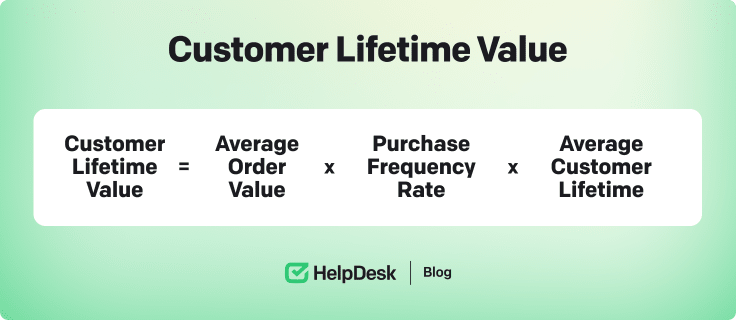
Key differentiators of your help desk system
Not all ticketing systems are created equal. The features of solutions such as CRM integration, automation, and advanced reporting can give your business a competitive edge by providing tangible benefits for both support and sales teams.
-
CRM integration: A system that integrates with your CRM ensures that sales and support teams are aligned, providing a comprehensive view of customer interactions. It leads to successful sales strategy and personalized customer service.
-
Automation and workflow optimization: Automation features like ticket routing, canned responses, and escalation rules reduce manual work, allowing support teams to focus on more complex issues.
-
Reporting and analytics: Advanced reporting tools allow businesses to identify trends in customer inquiries and tailor their sales strategies accordingly. Data-driven insights from help desk interactions help sales and support teams optimize their processes.
Many general systems need more deep integration and specific features of the help desk. For instance, while competitors might provide essential ticket management, HelpDesk offers automation, real-time reporting, and asynchronous communication, making it a more powerful tool for improving customer support and sales outcomes.
Summary
The exceptional customer support provided by the HelpDesk ticketing system is unmatched in terms of enhancing your sales cycle. The system is a game-changer — it reduces response times, fosters seamless collaboration between sales and support teams, and automates workflows to ensure everything runs smoothly.
With the capability to utilize data-driven insights, businesses can engage with leads more effectively and address their needs quickly. The result? A faster sales cycle, satisfied customers, and enduring loyalty.
Investing in the HelpDesk solution is your key to optimizing sales and establishing lasting relationships that drive growth and significantly increase profits.

